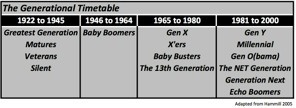
November 18, 2011
by Roy H. Bethge and Timothy Janowick
Law enforcement has been effected by many of the same changes faced by educational institutions and corporate America when it comes to how we prepare and train for the future. The old model of static lectures without engaging interaction between the student and instructor are no longer effective methods for teaching concepts and skills, especially those involving potential life and death decisions by police officers. It could be argued the changes in instructional style do not revolve around generational differences, rather in the changes all of us have undergone in our lifetime. However, intergenerational conflict presents challenges in the workplace considering the resulting obstructions to progress. Looking at the new models of instructional design with an eye towards generational change makes the idea easier to understand.
What are the Generations?
Each generation is shaped by the events, science, and social dynamics present as they grow and mature. The chart below provides an easy reference to help make sense of the four most recent generations and the time periods where they relate. It is important to understand where you fit into the timetable if you truly want to bridge the communication gap that exists between the generations. While not all researchers agree on the beginning and ending birth year of the various generations, Figure 1 provides a basic outline.
Generational Timetable – by Year of Birth (Figure 1)

Now that you know where you fit, spend a few moments thinking about some of the things that have affected you during your lifetime. Think about some of the big moments in history: the attempted assassination of Ronald Reagan, the Space Shuttle Challenger explosion, and the death of Princess Diana. If you think these things are not important or significantly relevant to your growing up, consider the following: “When asked to recall how and where Kennedy died, the Veterans and Baby Boomers would say gunshots in Dallas, Texas; Generation X remembers a plane crash near Martha’s Vineyard, Mass; and Generation Y might say, “Kennedy who?” (Hammill 2005). The social, political, and historical events of our youth proved to be formative to whom we are today.
Baby Boomers found themselves affected by the national and global political turmoil of their youth - the Vietnam War, the civil rights movement, and the assassinations of Kennedy and Martin Luther King, Jr. Members of this generation “believe that hard work and sacrifice are the price to pay for success” (Tolbize 2008) whereby paying their dues through excessive hours at work or bringing work home to complete led to a logical progression through promotions. Boomers found work ethic related to self-worth. As masters of their task, Boomers are not interested in constant feedback regarding their work. Chain of command is valued by Boomers, who view skipping supervisors to speak directly with managers as a violation of protocol and disrespectful to the supervisor. As the first generation to experience the technological revolution, Boomers experienced the advent of rotary telephones on walls and sitting on desks, the development of the first computers, and the first to go to power steering.
Generation X grew up in an era of Bill Gates, the advent of the personal computer, and early cellular telephones permanently mounted in vehicles or carried in large black bags. Known for being “latchkey” kids who spent many hours home alone due to dual-income parents or single parents as a result of divorce - they learned to fend for themselves. A product of the latchkey generation is their autonomy and independence, although this does not preclude them from enjoying teamwork - and more so than Boomers. The generation experienced upheaval in politics, the economy, and society. As a result of their experiences in their youth, Xers attempt to create a balance between work and family, and are not found to be overly loyal to their employer as a consequence. Managers have labeled Xers as being slackers, lazy, or uncommitted due to the failure to display fervent loyalty to their employer. Xers value continuous learning,
For many Baby Boomers and Generation X’ers, the current state of innovation remains somewhat foreign, but countless numbers have adapted to the changes beyond their developmental years. As a general statement, adaptation has come about slowly and often, painfully, for many. However, one observation rings true - the Boomers and the X’ers have created organizations catering to their needs, needs often contrary to those of the following generation.
Now lets look at Generation Y who grew up with instant access to information, multiple computers in their homes, and cellular telephones glued to their fingertips. One of the major criticisms heard about Generation Y is that they grew up in a system where they never failed. Awards were given out just for participating in a sport or event regardless of who won or lost. Losing, and thus coping, were not concepts ingrained in them as youths, unlike generations before them. What Generation Y did grow up with was a first hand view of extreme violence. Think Columbine, Virginia Tech, World Trade Center. In contrast to national news coverage of World War II where film reels were sent home via airplane to be broadcast a few days later, Gen Y grew up with the 24-hour news cycle. They watched as the violent events unfolded, live, right before their eyes.
Characteristics of Each Generation (Figure 2)

How does this affect law enforcement training?
Traditional educational systems focus on a structured industrial model of education. Students are divided into classes based on their ages rather than their skill level. The other students in the in class and school represent the same generation. The classroom dynamic of instructing across multiple levels of skill development and methods of learning require law enforcement trainers to become adept in their methodology and technique. It is important to understand generational differences if we hope to create training with a positive impact on improving the skills of our officers and potentially changing the learning culture of law enforcement.
The challenge is increased across the generations as different tactics are employed to engage learners in the process. Boomers may be adverse to team or group activities, while Xers and Gen Y will relish in the experience, preferring group discussion and peer feedback as sources of learning. Supervisors may have witnessed the latter activity as new recruits frequently seek immediate feedback regarding their performance on calls by asking their peers either in person or electronically for an assessment. Xers may also seek independent tasks in the learning environment and focus on learning with fervency, while the youngest members of the workforce can be found using technology to enhance their learning during class.
Although certain strategies in providing instruction may need to be adapted for the differing ages of the learners, adult learners across the board have certain expectations in common: a desire for relevancy to them personally and their work, a need to be addressed, Some simple concepts often applied in instructional design found in corporate America can help law enforcement trainers improve outcomes. In his book Getting Them to Give A Damn (Chester 2005) makes the following recommendations:
•Begin with an orientation, not skills training
•Assess what they know
•Make it fresh
•Keep up the pace
•Reward skills development
While meeting the basic needs of adult learners, trainers must be cognizant of the fact Baby Boomers, X’ers, and Generation Y have embraced advancements in technology from smart phones to digital book readers to computerized gaming. Law enforcement instructors who want to remain on top of their field and make substantial improvements must figure out methods to incorporate this technology into the training environment. Training programs must take on a flair for creativity in design and action rather than the static assembly line of old.
Participants should be challenged in a safe environment and allowed to make mistakes in the training environment. It is only through these mistakes that students can truly learn. Failure in the training environment is correctable. In the real world, failure can be fatal.
Conclusion
Understanding certain key differences between generations can allow for greater success when presenting training to police officers. Although the differing styles may cause trainers to create a careful balance in delivery methods, doing so can allow for the greatest levels of engagement and learning. In recognizing how the generations prefer to receive feedback and at what frequency, trainers will be able to avoid insulting Boomers while ensuring Xers and Gen Y members are not left in angst. The more aware of generation differences an instructor is, the more successful the learning experience can be.
References
Chester, E. Getting Them to Give a Damn. Chicago: Dearborn Trade Publishing, 2005.
Hammill, G. FDU Magazine Online. 2005. http://www.fdu.edu/newspubs/magazine/05ws/generations.htm (accessed October 29, 2011).
Tolbize, Anick. Generational differences in the workplace. Research and Training Center on Community Living, University of Minnesota. 2008.
